by rhamilton | Jun 18, 2018 | Updates
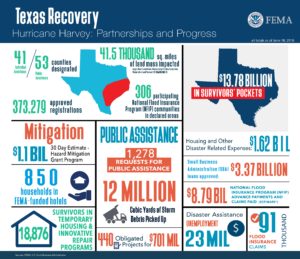 Infographics make it easy to understand the facts and figures of the local recovery efforts throughout Texas following Hurricane Harvey.
Infographics make it easy to understand the facts and figures of the local recovery efforts throughout Texas following Hurricane Harvey.
These infographics were compiled, created, and updated by the Federal Emergency Management Agency (FEMA). They include information about the assistance provided so far, the number of survivors currently in temporary housing and innovative repair programs, and more.
The statewide figures were updated on June 18, 2018, and the county-by-county information – as well as the city-specific information for Houston, Port Aransas, and Rockport – is current as of June 15, 2018. All infographics will continue to be updated throughout the recovery process.
You can view or download the latest recovery infographics for the state, for all counties, and for three specific cities affected by Hurricane Harvey below.
Statewide:
Download (PDF, 12.98MB)
Counties and Select Cities:
Download (PDF, 4.11MB)
by rhamilton | Jun 12, 2018 | Updates
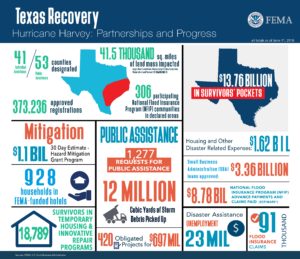 Infographics make it easy to understand the facts and figures of the local recovery efforts throughout Texas following Hurricane Harvey.
Infographics make it easy to understand the facts and figures of the local recovery efforts throughout Texas following Hurricane Harvey.
These infographics were compiled, created, and updated by the Federal Emergency Management Agency (FEMA). They include information about the assistance provided so far, the number of survivors currently in temporary housing and innovative repair programs, and more.
The statewide figures were updated on June 11, 2018, and the county-by-county information – as well as the city-specific information for Houston, Port Aransas, and Rockport – is current as of June 8, 2018. All infographics will continue to be updated throughout the recovery process.
You can view or download the latest recovery infographics for the state, for all counties, and for three specific cities affected by Hurricane Harvey below.
Statewide:
Download (PDF, 13.03MB)
Counties and Select Cities:
Download (PDF, 4.11MB)
by teaton | Jun 6, 2018 | Updates
 Commissioner of Education Mike Morath announced Wednesday that campuses, school districts and open-enrollment charter schools directly affected by Hurricane Harvey will be eligible for special evaluation in this year’s state accountability system, if they meet a specific criterion.
Commissioner of Education Mike Morath announced Wednesday that campuses, school districts and open-enrollment charter schools directly affected by Hurricane Harvey will be eligible for special evaluation in this year’s state accountability system, if they meet a specific criterion.
Under the Hurricane Harvey Provision, 2018 accountability ratings will be generated for eligible districts, charter schools and campuses using available data, such as:
- If a campus meeting at least one of the Hurricane Harvey criteria receives an “Improvement Required” rating, the campus will be labeled “Not Rated.”
- If a district or open-enrollment charter school meeting at least one of the Hurricane Harvey criteria receives a B, C, D, or F rating, the district or open-enrollment charter school will be labeled “Not Rated.” (As part of House Bill 22, districts will receive a rating of A, B, C, D or F in 2018.)
The established criteria are based on data reported by districts and charter schools to the Texas Education Agency over the past school year. The data reported indicates the number of displaced students and teachers, as well as the impact on local school facilities and instructional time. Districts and charters were given several opportunities to submit information regarding students, teachers and facilities throughout the school year.
Campuses will be evaluated under the Hurricane Harvey Provision if they meet at least one of the following criteria:
- The campus identified 10 percent or more of enrolled students with specific crisis codes for displaced or homeless students. Campus enrollment is based on October snapshot data; OR
- The campus reported 10 percent or more of its teachers experienced homelessness due to Hurricane Harvey (as reported in a Homeless Survey announced Feb. 14, 2018); OR
- The campus was reported to TEA as closed for 10 or more instructional days due to Hurricane Harvey; OR
- The campus was reported to TEA as displaced due to Hurricane Harvey either because the student population was relocated to another geographic location (at least through winter break) or the student population was required to share its own campus facility with the students of another campus closed as a direct result of Hurricane Harvey (at least through winter break).
This represents a substantial expansion to storm-related accountability adjustments when compared to prior storms in Texas. For example, Hurricane Ike in 2008 resulted in accountability adjustments for campuses based only on one of the above criteria – whether a campus was closed 10 or more days.
School districts and open-enrollment charter schools will be labeled “Not Rated” if all campuses within the school district or open-enrollment charter school receive a “Not Rated” label as a result of the Hurricane Harvey Provision. Additionally, if 10 percent or more of the school district or open-enrollment charter school’s students were enrolled in a campus labeled “Not Rated” under the Hurricane Harvey Provision, the school district or open-enrollment charter school will be labeled “Not Rated.”
For purposes of counting consecutive years of ratings, 2017 and 2019 will be considered consecutive for school districts, open-enrollment charter schools and campuses receiving a “Not Rated” label in 2018 due to hurricane-related issues.
Any hurricane-affected school district, open-enrollment charter school, or campus not identified as eligible for this provision may appeal under the accountability appeals process.
The Hurricane Harvey Provision will be part of an administrative rule-making process to adopt the 2018 Accountability Manual. The provision was formally posted on the Texas Register website and available for public comment on June 5. It is also available on the TEA website during the public comment period. To view a PDF copy of the Hurricane Harvey Provision, visit https://tea.texas.gov/2018accountabilitymanual.aspx.
by rhamilton | Jun 4, 2018 | Updates
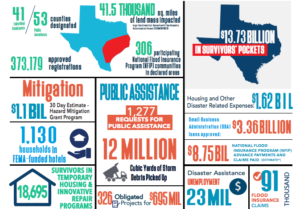 Infographics make it easy to understand the facts and figures of the local recovery efforts throughout Texas following Hurricane Harvey.
Infographics make it easy to understand the facts and figures of the local recovery efforts throughout Texas following Hurricane Harvey.
These infographics were compiled, created, and updated by the Federal Emergency Management Agency (FEMA). They include information about the assistance provided so far, the number of survivors currently in temporary housing and innovative repair programs, and more.
The statewide figures were updated on June 4, 2018, and the county-by-county information – as well as the city-specific information for Houston, Port Aransas, and Rockport – is current as of June 1 2018. All infographics will continue to be updated throughout the recovery process.
You can view or download the latest recovery infographics for the state, for all counties, and for three specific cities affected by Hurricane Harvey below.
Statewide:
Download (PDF, 13.03MB)
Counties and Select Cities:
Download (PDF, 4.1MB)
by rhamilton | Jun 1, 2018 | Updates
 “Though smaller trees were felled by Hurricane Harvey’s fierce winds and torrential rains, the more than 1,000-year-old Big Tree at Goose Island State Park near Rockport withstood the historic storm’s wrath—as it did for centuries during every previous hurricane, as it did through fire, flood and damaging drought. Now, nine months after Hurricane Harvey destroyed so many other treasures, new leaves are growing back on the Big Tree. The mighty old oak stands as a symbol of strength—mirroring the resilience of the people of the Coastal Bend region. Rockport and Fulton are rebuilding: According to the Chamber, more than 70 percent of businesses are up and running, sales tax collections are trending upward, more than 1,000 vacation rentals and hotels will be open mid-summer and real estate sales are rebounding. I am so inspired by the teamwork, partnership and perseverance shown by leaders, businesses and citizens in all of our communities. While each day brings more progress, and more families returning home, our job is not yet done, recovery is not yet complete. But we remain—like the Big Tree—#TexasStrong.” ─ Governor Greg Abbott
“Though smaller trees were felled by Hurricane Harvey’s fierce winds and torrential rains, the more than 1,000-year-old Big Tree at Goose Island State Park near Rockport withstood the historic storm’s wrath—as it did for centuries during every previous hurricane, as it did through fire, flood and damaging drought. Now, nine months after Hurricane Harvey destroyed so many other treasures, new leaves are growing back on the Big Tree. The mighty old oak stands as a symbol of strength—mirroring the resilience of the people of the Coastal Bend region. Rockport and Fulton are rebuilding: According to the Chamber, more than 70 percent of businesses are up and running, sales tax collections are trending upward, more than 1,000 vacation rentals and hotels will be open mid-summer and real estate sales are rebounding. I am so inspired by the teamwork, partnership and perseverance shown by leaders, businesses and citizens in all of our communities. While each day brings more progress, and more families returning home, our job is not yet done, recovery is not yet complete. But we remain—like the Big Tree—#TexasStrong.” ─ Governor Greg Abbott
Governor’s Commission to Rebuild Texas
- Governor Abbott urges Texans to protect lives and property by preparing for Hurricane Season, which begins today, June 1. In addition to #HurricanePrep tips on Twitter and Facebook, the Office of the Governor’s website includes planning tips and resources.
- Governor Abbott reminds Texans to review their property’s flood risk and current insurance coverage, and to consider whether a separate flood policy should be part of their home protection plan. Most flood policies have a 30-day waiting period before taking effect. Visit FloodSmart.gov to find more information.
- Governor Abbott announced that FEMA has granted Texas’ request to extend the deadline for Transitional Sheltering Assistance (TSA) for Hurricane Harvey survivors. TSA helps displaced individuals who are unable to return to their homes find short-term shelter in hotels or other temporary housing locations. The TSA deadline has been extended through June 30, 2018, with a checkout date of July 1, 2018. Disaster victims with questions regarding their TSA program eligibility or status may contact the FEMA Helpline at 800-621-3362 for assistance.
- Governor Abbott sent a letter approving a request by the Harris County Commissioners Court to hold an emergency special election for a bond referendum on Sat., Aug. 25.
- Governor Abbott urges community leaders to take immediate advantage of the $500 million in funds from FEMA’s Hazard Mitigation Grant Program that are available now, with $600 million more becoming available in August 2018. The Texas Department of Emergency Management (TDEM) stands ready to assist with those applications.
- Commissioner John Sharp was interviewed by KLRD News Radio, where he gave an update on recovery efforts and echoed the Governor’s advice for Texans to consider purchasing flood insurance before disaster strikes.
- The U.S. Army Corps of Engineers announced an initial list of projects to address high-priority needs in states recently impacted by natural disasters, including several in Texas in the aftermath of Hurricane Harvey: Buffalo Bayou and Tributaries; Corpus Christi Ship Channel; Galveston Harbor and Channel; GIWW, Channel to Victoria; Gulf Intracoastal Waterway; Houston Ship Channel; Matagorda Ship Channel; Sabine Neches Waterway; and Wallisville Lake.
- As of the end of May, 6,487 reports have been submitted from the field to the Assistance Center at Texas A&M. From those reports, the Assistance Center identified 743 issues needing follow-up or resolution, and all but one have been resolved.
Individual Assistance
- The TSA deadline has been extended through June 30, 2018, with a checkout date of July 1, 2018. Disaster victims with questions regarding their TSA program eligibility or status may contact the FEMA Helpline at 800-621-3362 for assistance.
- Current individual assistance numbers are now posted on rebuildtexas.today/recovery-tracker.
- To find the nearest Disaster Recovery Center visit fema.gov/drc, or text DRC along with a zip code to 43362 (4FEMA). Survivors also can find help by calling FEMA at 800-621-3362, logging into DisasterAssistance.gov or downloading the FEMA app fema.gov/mobile-app.
- FEMA’s Disaster Distress Helpline offers trained professionals who can help callers cope with anxiety or stress, and guide them to available resources. This toll-free, multilingual and confidential crisis support service is open 24 hours a day, seven days a week. Call 800-985-5990, 800-846-8517 (TTY) or text TalkWithUs (Spanish-speakers text: Hablanos) to 66746.
Housing
Governor Abbott and Texas Land Commissioner George P. Bush announced more than 15,000 homes have received repairs through the Partial Repair and Essential Power for Sheltering (PREPS) program in coordination with FEMA. The PREPS program provides basic repairs that allow homeowners to live in their homes and their communities as they make more permanent repairs to their homes. Up to $20,000 in repairs, including restoring electricity, air conditioning/heating, and hot water, debris removal, limited drywall and insulation, and restoring a functional bathroom and kitchen facilities, have been provided to return the homes to a standard that is safe, sanitary and secure. To date, this new program has provided repair assistance for more than 45,000 Texans.
With Hurricane Season beginning today, June 1, FEMA reminds residents that Manufactured Housing Units (MHUs) are designed to be exceptionally safe and secure, but all forms of housing are at risk for damage in severe weather. Never take shelter in an MHU during high winds, a tornado, a hurricane or a flood. Stay alert to weather warnings, and always follow the guidance of local officials including evacuation orders. If your MHU is damaged due to severe weather, contact the maintenance number provided when licensed in the unit.
Reminder: Flood insurance must be maintained to qualify for federal assistance in the future. The National Flood Insurance Program (NFIP) policyholders with questions may call 800-621-3362, Mon. to Sat., 7 a.m. to 7 p.m. For information, visit FloodSmart.gov.
Current housing numbers are now posted on rebuildtexas.today/recovery-tracker.
TexasRebuilds.com is the housing information resource for individuals and communities.
Follow Twitter.com/TXGLO for pictures of move-in days and updates on housing recovery.
by rhamilton | May 29, 2018 | Updates
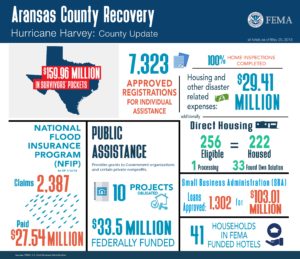 Infographics make it easy to understand the facts and figures of the local recovery efforts throughout Texas following Hurricane Harvey.
Infographics make it easy to understand the facts and figures of the local recovery efforts throughout Texas following Hurricane Harvey.
These infographics were compiled, created, and updated by the Federal Emergency Management Agency (FEMA). They include information about the assistance provided so far, the number of survivors currently in temporary housing and innovative repair programs, and more.
The statewide figures were updated on May 29, 2018, and the county-by-county information – as well as the city-specific information for Houston, Port Aransas, and Rockport – is current as of May 25, 2018. All infographics will continue to be updated throughout the recovery process.
You can view or download the latest recovery infographics for the state, for all counties, and for three specific cities affected by Hurricane Harvey below.
Statewide:
Download (PDF, 13.03MB)
Counties and Select Cities:
Download (PDF, 4.11MB)
 Infographics make it easy to understand the facts and figures of the local recovery efforts throughout Texas following Hurricane Harvey.
Infographics make it easy to understand the facts and figures of the local recovery efforts throughout Texas following Hurricane Harvey.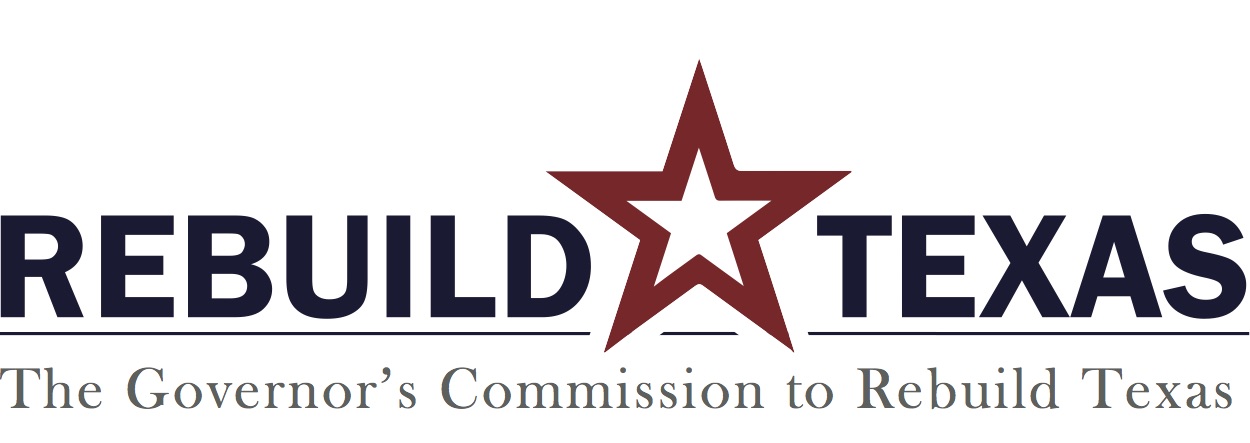
 Infographics make it easy to understand the facts and figures of the local recovery efforts throughout Texas following Hurricane Harvey.
Infographics make it easy to understand the facts and figures of the local recovery efforts throughout Texas following Hurricane Harvey. Commissioner of Education Mike Morath announced Wednesday that campuses, school districts and open-enrollment charter schools directly affected by Hurricane Harvey will be eligible for special evaluation in this year’s state accountability system, if they meet a specific criterion.
Commissioner of Education Mike Morath announced Wednesday that campuses, school districts and open-enrollment charter schools directly affected by Hurricane Harvey will be eligible for special evaluation in this year’s state accountability system, if they meet a specific criterion. Infographics make it easy to understand the facts and figures of the local recovery efforts throughout Texas following Hurricane Harvey.
Infographics make it easy to understand the facts and figures of the local recovery efforts throughout Texas following Hurricane Harvey. “Though smaller trees were felled by Hurricane Harvey’s fierce winds and torrential rains, the more than 1,000-year-old Big Tree at Goose Island State Park near Rockport withstood the historic storm’s wrath—as it did for centuries during every previous hurricane, as it did through fire, flood and damaging drought. Now, nine months after Hurricane Harvey destroyed so many other treasures, new leaves are growing back on the Big Tree. The mighty old oak stands as a symbol of strength—mirroring the resilience of the people of the Coastal Bend region. Rockport and Fulton are rebuilding: According to the Chamber, more than 70 percent of businesses are up and running, sales tax collections are trending upward, more than 1,000 vacation rentals and hotels will be open mid-summer and real estate sales are rebounding. I am so inspired by the teamwork, partnership and perseverance shown by leaders, businesses and citizens in all of our communities. While each day brings more progress, and more families returning home, our job is not yet done, recovery is not yet complete. But we remain—like the Big Tree—#TexasStrong.” ─ Governor Greg Abbott
“Though smaller trees were felled by Hurricane Harvey’s fierce winds and torrential rains, the more than 1,000-year-old Big Tree at Goose Island State Park near Rockport withstood the historic storm’s wrath—as it did for centuries during every previous hurricane, as it did through fire, flood and damaging drought. Now, nine months after Hurricane Harvey destroyed so many other treasures, new leaves are growing back on the Big Tree. The mighty old oak stands as a symbol of strength—mirroring the resilience of the people of the Coastal Bend region. Rockport and Fulton are rebuilding: According to the Chamber, more than 70 percent of businesses are up and running, sales tax collections are trending upward, more than 1,000 vacation rentals and hotels will be open mid-summer and real estate sales are rebounding. I am so inspired by the teamwork, partnership and perseverance shown by leaders, businesses and citizens in all of our communities. While each day brings more progress, and more families returning home, our job is not yet done, recovery is not yet complete. But we remain—like the Big Tree—#TexasStrong.” ─ Governor Greg Abbott Infographics make it easy to understand the facts and figures of the local recovery efforts throughout Texas following Hurricane Harvey.
Infographics make it easy to understand the facts and figures of the local recovery efforts throughout Texas following Hurricane Harvey.